Computer history
These inventions that were the roots of the tree that led to the development of the first computer...
Let's start by defining the computer word:
An automatic information processing machine that obeys programs formed as a result of arithmetic and logical operations. (Larousse)
Electronic, magnetic, optical, electrochemical or any other high-speed data processing method by performing logical, arithmetic or storage functions. (U.S. Penal Code 7-33-4).
In both cases, this includes smartphones and tablets.
Inventions
Abak or shield invented in ancient China.
Clock. Bolter considers the invention of the pendulum under weight control as a key invention of middle-aged Europe, in particular the mechanisms producing tick-dachshunds of mechanical watches. This led directly to the mechanical automata of the early twentieth century.
Pascaline, Blaise Pascal's first calculator.
Jacquard's profession (1801). He caused a Luddite revolt.
Printed tape (end of 1800).
Telegraph, (milieu1800) forerunner of the telephone.
Babbage Difference Machine (1821). The first language developed by Ada Lovelace.
Hollerith maps (punctured maps, 1887).
Teletype (1910).
Electromechanical relay (1935). With its two open and closed "binary states."
Digital binary addition device (1937) by George Stibitz, based on repeaters.
Claude Shannon shows in his dissertation at MIT how to implement Boole algebra with electronic repeaters (1937).
Bodo code recorded on tapes.
EDVAC design. Von Neumann architecture.
Magnetic memory (1954).
Microprogramming (1955). The set of basic instructions can be extended for each program. This is firmware.
Magnetic disk (1956). RAMAC is introduced by IBM.
Integrated circuit. Bring the third generation of computers to the 60s.
Computers
Antifir machine. Built in 87 BC e., this calculator made it possible to predict the position of asters. Functional reproduction was done these days (video).
Analog calculators. Until 1940.
Georges Stiblitz's K model is the first calculator using relays (1937).
Series Z by Konrad Zuse. Z1 in 1936. He occupied several rooms in his parents' house.
Atanasoff-Berry (1938). Specialized calculator for solving linear equations.
Harvard Mark I (1939). IBM, in digital arithmetic as Babbage's machine.
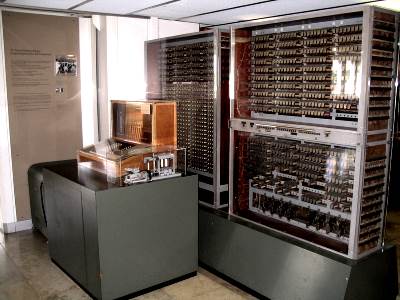
Z3 at the German Museum, Munich
Z3 (1941) by Konrad Zuse. Binary floating point system. Turing-complete. Zuse patents were bought by IBM.
Colossus (1943). Used to split codes.
ENIAC (1945). Electronic digital integrator and computer. Digital Computer, University of Pennsylvania. Turing-complete.
EDSAK (1949). University of Cambridge. The first to implement von Neumann architecture. Programs and data are stored together.
EDVAK. Electronic discretionary variable automatic computer, successor to ENIAC (not EDSAC).
Ferranti Mark I (1951). University of Manchester.
UNIVAC I (1951). Universal automatic computer. Remington Rand.
IBM 701 (1952). First mainframe.
IBM 704 (1954). Represents ferrite memory cores.
Microprocessor (1971).
The 4-bit Intel 4004 appeared in 1971. The first 8-bit, Intel 8008 appeared in 1972. Popular 8080 in 1974.
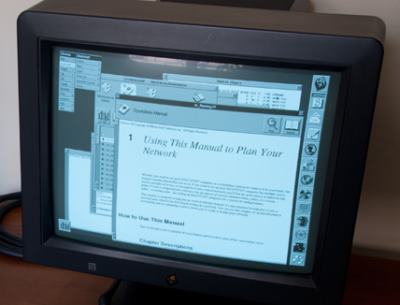
Computer Next
Microprocessor MOS 6502 (1975). A cheap processor costs $25 versus $300 for the motorola 6800 (1974), paving the way for microcomputers.
Microcomputer. Who invented it? The first versions appeared in 1976 along with KIM 1, Altair 8800, Apple I.
It became popular in 1977 with the Apple II, TRS-80 and Commodore.
IBM PC in 1981 launches the success of the microcomputer in business .
In 1982, the Commodore C-64 was released, the best-selling with 22 million units.
The second commercial computer in the GUI, after Lisa's failure in 1983, the Macintosh appeared in January 1984. Imitated by Atari ST and Amiga in 1985, with color screens .
NeXT Cube, was very ahead of his time. and its NeXTStep operating system would become an operating system with the return of Steve Jobs in 1997. In 1988, the interface already had a sidebar of icons, which will appear on Ubuntu in more than 20 years !
In 1994, the devices combined the capabilities of a telephone and a personal assistant. With an operating system, these are miniature mobile computers. The term smartphone appears in 1997.
Windows would adopt the GUI in 1995.
In 2008, the iPhone popularizes the smartphone among the masses: a mobile phone can make applications work, it's a computer.
In 2010, tablets became popular thanks to the iPad, another idea from Steve Jobs. This is the beginning of the slow decline of the desktop computer at the private trader. However, tablets are a consumption tool and do not completely replace the desktop PC, which is a manufacturing tool .
First microcomputers
- 1974. Altair 8800 by MITS. Powered by an Intel 8080 processor.
- 1977.
Apple] [with color screen. It has a MOS 6502 processor. Screen with a resolution of 280x192 pixels or 40x24 characters.
TRS-80 от Radio Shack. Monochrome. Zilog Z80 processor, clone 8080.
Commodore PET, 6502 processor. Monochome. - 1978. Apple II is equipped with a hard drive.
- 1979. Acorn System 75.
- 1980. Z80.
- 1981.
IBM PC 5150 with 8088 processor. Low-resolution CGA graphics screen.
Commodore VIC 20. - 1982. Commodore 64, similar to the Apple II, except for the screen resolution. Processor 6502 version 6510/8500 .
- 1983. Apple Lisa.
1984. Apple MacIntosh. - 1985.
Commodore's Amiga with a 68000 processor.
Atari ST with the same processor.
Desktop Size Change 1981-2014
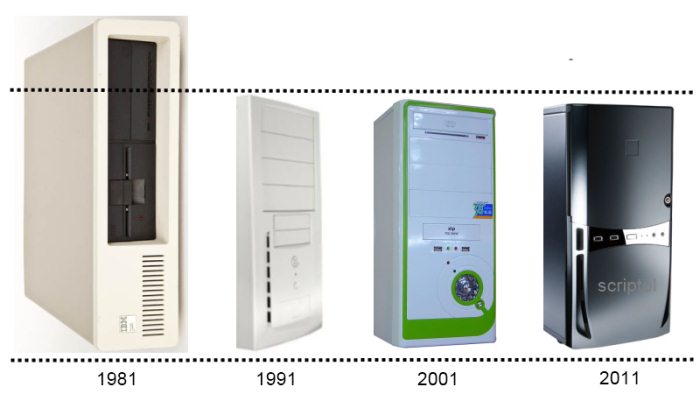
According to the results of benchmarks conducted with Linpack, in 2011 the speed of the top 10 smartphones exceeds 200 megaflops.
According to these benchmarks on desktop PCs, this is equivalent to a computer equipped with a 4 GhZ 2 Pentium 2006.
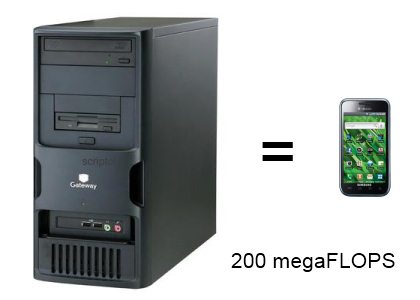
A modern smartphone that is held in your hands at the same power as the Gateway E 2500 2006, equipped with Pentium 4.
We can say that there is like a lock in resizing computers. However, Intel is trying to reduce the size of PCs with Nuc, and it turned out that this is the only type of desktop PC that is growing in sales in 2014.
Storage Technology Advancements
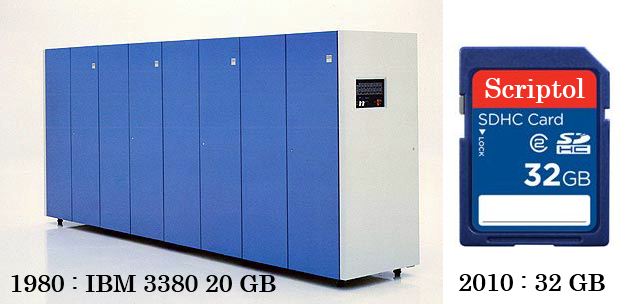
The 3380 IBM drive could hold 2.5 GB of data. Combining eight of them, we got 20 GB for a set weighing 2 tons. Then it cost 100 thousand dollars (75 thousand euros).
Now (in 2010) we come to 32 GB on an SD card weighing 1 gram and costing about a hundred euros! In February 2014, a 128 GB micro SD is sold.
See also...
- History of programming languages.
- Algorithm history.
- New Computer Technology: New Computers .